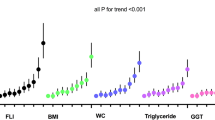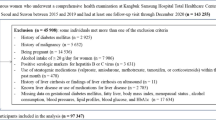Abstract
Background and purpose
A recent international expert consensus opinion suggested that metabolic dysfunction-associated fatty liver disease (MAFLD) replaces nonalcoholic fatty liver disease (NAFLD), since MAFLD is a better predictor of cardiovascular disease. We estimated the prevalence of FLD in fertile females and evaluated the clinical impact of either NAFLD or MAFLD on maternal and fetal outcomes during subsequent pregnancy.
Methods
The study population included fertile females who underwent health examinations and became pregnant within 1 year of health examination. Hepatic steatosis was defined as a fatty liver index of ≥ 30. The fertile females were divided into four groups: neither-FLD, NAFLD-only, MAFLD-only, and both-FLDs. During subsequent pregnancy, the risks of adverse pregnancy outcomes, including gestational diabetes, pregnancy-associated hypertension, preterm birth, and low birthweight, were compared among the four groups.
Results
The study population comprised 762,401 females, including 720,606 with neither-FLD, 318 with NAFLD-only, 14,371 with MAFLD-only, and 27,106 with both-FLDs. Compared to females with neither-FLD, the risk of adverse pregnancy outcomes was higher in females with any FLD, with an adjusted OR of 1.73 (95% CI 1.25–2.41) in the NALFD-only group, 2.65 (2.53–2.77) in the MAFLD-only group, and 2.39 (2.31–2.48) in the both-FLDs group. Pregnancy outcomes (cesarean delivery, gestational diabetes, and low birthweight) were worse in females with MAFLD compared with NAFLD.
Conclusion
Any form of FLD is a risk factor for adverse pregnancy outcomes. These data suggest that MAFLD is associated with a higher risk of adverse pregnancy outcomes for both mother and fetus than NAFLD.



Similar content being viewed by others
Data availability
The dataset was obtained from the National Health Insurance Service. Data cannot be shared publicly due to the violation of patient privacy and the absence of informed consent for data sharing.
Abbreviations
- BMI:
-
Body mass index
- GDM:
-
Gestational diabetes mellitus
- GGT:
-
Gamma-glutamyl transferase
- HDL:
-
High-density lipoprotein
- MD:
-
Metabolic dysfunction
- MAFLD:
-
MD-associated fatty liver disease
- NAFLD:
-
Nonalcoholic fatty liver disease
- TG:
-
Triglycerides
- WC:
-
Waist circumference
References
Younossi ZM, Koenig AB, Abdelatif D, et al. Global epidemiology of nonalcoholic fatty liver disease-meta-analytic assessment of prevalence, incidence, and outcomes. Hepatology. 2016;64(1):73–84
Marchesini G, Brizi M, Bianchi G, et al. Nonalcoholic fatty liver disease: a feature of the metabolic syndrome. Diabetes. 2001;50(8):1844–1850
Eslam M, Sanyal AJ, George J, et al. MAFLD: a consensus-driven proposed nomenclature for metabolic associated fatty liver disease. Gastroenterology. 2020;158(7):1999 e1991-2014 e1991
Eslam M, Newsome PN, Sarin SK, et al. A new definition for metabolic dysfunction-associated fatty liver disease: an international expert consensus statement. J Hepatol. 2020;73(1):202–209
Yamamura S, Eslam M, Kawaguchi T, et al. MAFLD identifies patients with significant hepatic fibrosis better than NAFLD. Liver Int. 2020;40(12):3018–3030
Jeong S, Oh YH, Choi S, et al. Metabolic dysfunction-associated fatty liver disease better predicts incident cardiovascular disease. Gut Liver. 2021;16:589–598
Moon JH, Kim W, Koo BK, et al. Metabolic dysfunction-associated fatty liver disease predicts long-term mortality and cardiovascular disease. Gut Liver. 2022;16(3):433–442
Lee SM, Jung YM, Choi ES, et al. Metabolic dysfunction-associated fatty liver disease and subsequent development of adverse pregnancy outcomes. Clin Gastroenterol Hepatol. 2022;20(11):2542–2550.e8
Lee SM, Kim W. Nonalcoholic fatty liver disease-based risk prediction of adverse pregnancy outcomes: ready for prime time? Clin Mol Hepatol. 2022;28(1):47–49
Sattar N, Greer IA. Pregnancy complications and maternal cardiovascular risk: opportunities for intervention and screening? BMJ. 2002;325(7356):157–160
Kramer CK, Campbell S, Retnakaran R. Gestational diabetes and the risk of cardiovascular disease in women: a systematic review and meta-analysis. Diabetologia. 2019;62(6):905–914
Kessous R, Shoham-Vardi I, Pariente G, et al. An association between gestational diabetes mellitus and long-term maternal cardiovascular morbidity. Heart. 2013;99(15):1118–1121
Fadl H, Magnuson A, Ostlund I, et al. Gestational diabetes mellitus and later cardiovascular disease: a Swedish population based case-control study. BJOG. 2014;121(12):1530–1536
Savitz DA, Danilack VA, Elston B, et al. Pregnancy-induced hypertension and diabetes and the risk of cardiovascular disease, stroke, and diabetes hospitalization in the year following delivery. Am J Epidemiol. 2014;180(1):41–44
Wu P, Mamas MA, Gulati M. Pregnancy As a predictor of maternal cardiovascular disease: the era of cardioobstetrics. J Womens Health. 2019;28(8):1037–1050
Sondergaard MM, Hlatky MA, Stefanick ML, et al. Association of adverse pregnancy outcomes with risk of atherosclerotic cardiovascular disease in postmenopausal women. JAMA Cardiol. 2020;5(12):1390–1398
Ozturk HNO, Turker PF. Fetal programming: could intrauterin life affect health status in adulthood? Obstet Gynecol Sci. 2021;64(6):473–483
Lee SM, Kwak SH, Koo JN, et al. Non-alcoholic fatty liver disease in the first trimester and subsequent development of gestational diabetes mellitus. Diabetologia. 2019;62(2):238–248
Lee SM, Kim BJ, Koo JN, et al. Nonalcoholic fatty liver disease is a risk factor for large-for-gestational-age birthweight. PLoS ONE. 2019;14(8): e0221400
Jung YM, Lee SM, Hong S, et al. The risk of pregnancy-associated hypertension in women with nonalcoholic fatty liver disease. Liver Int. 2020;40(10):2417–2426
Sarkar M, Grab J, Dodge JL, et al. Non-alcoholic fatty liver disease in pregnancy is associated with adverse maternal and perinatal outcomes. J Hepatol. 2020;73(3):516–522
El Jamaly H, Eslick GD, Weltman M. Systematic review with meta-analysis: Non-alcoholic fatty liver disease and the association with pregnancy outcomes. Clin Mol Hepatol. 2022;28(1):52–66
Seong SC, Kim YY, Park SK, et al. Cohort profile: the National Health Insurance Service-National Health Screening Cohort (NHIS-HEALS) in Korea. BMJ Open. 2017;7(9): e016640
D’Antonio F, Odibo AO, Prefumo F, et al. Weight discordance and perinatal mortality in twin pregnancy: systematic review and meta-analysis. Ultrasound Obstet Gynecol. 2018;52(1):11–23
European Association for the Study of the L, European Association for the Study of D, European Association for the Study of O. EASL-EASD-EASO Clinical Practice Guidelines for the management of non-alcoholic fatty liver disease. J Hepatol. 2016;64(6):1388–1402
Lee YH, Bang H, Park YM, et al. Non-laboratory-based self-assessment screening score for non-alcoholic fatty liver disease: development, validation and comparison with other scores. PLoS ONE. 2014;9(9): e107584
Lee H, Lee YH, Kim SU, et al. Metabolic dysfunction-associated fatty liver disease and incident cardiovascular disease risk: a nationwide cohort study. Clin Gastroenterol Hepatol. 2021;19(10):2138 e2110-2147 e2110
Bedogni G, Bellentani S, Miglioli L, et al. The fatty liver index: a simple and accurate predictor of hepatic steatosis in the general population. BMC Gastroenterol. 2006;6:33
Harrison SA, Oliver D, Arnold HL, et al. Development and validation of a simple NAFLD clinical scoring system for identifying patients without advanced disease. Gut. 2008;57(10):1441–1447
Park JT, Kim BG, Jhun HJ. Alcohol consumption and the CAGE questionnaire in Korean adults: results from the Second Korea National Health and Nutrition Examination Survey. J Korean Med Sci. 2008;23(2):199–206
Lim S, Kim JW, Targher G. Links between metabolic syndrome and metabolic dysfunction-associated fatty liver disease. Trends Endocrinol Metab. 2021;32(7):500–514
Park SH, Plank LD, Suk KT, et al. Trends in the prevalence of chronic liver disease in the Korean adult population, 1998–2017. Clin Mol Hepatol. 2020;26(2):209–215
Chou R, Wasson N. Blood tests to diagnose fibrosis or cirrhosis in patients with chronic hepatitis C virus infection: a systematic review. Ann Intern Med. 2013;158(11):807–820
Funding
This work was supported by the Seoul National University Hospital research fund (0320212200), a National Research Foundation of Korea grant funded by the Korean government (MEST) (2021R1A2C2005820, 2021M3A9E4021818, 2021R1F1A1046707). This work was also supported by a grant of the Korea Health Technology R&D Project through the Korea Health Industry Development Institute (KHIDI), funded by the Ministry of Health & Welfare, Republic of Korea (HI19C0502).
Author information
Authors and Affiliations
Contributions
SML, GJC, WK, and JSP designed the research; SML, GJC, BKK, WWY, JL, YMJ, SHK, ERN, CWP, JKJ, SKJ, MJO, WK, and JSP conducted the research; SML, GJC, WWY, and WK analyzed the data; SML, GJC, WK, and JSP wrote the manuscript; SML, GJC, BKK, WWY, JL, YMJ, SHK, ERN, CWP, JKJ, SKJ, MJO, WK, and JSP revised the manuscript; WK and JSP had access to all the data and had primary responsibility for the final content.
Corresponding authors
Ethics declarations
Competing interest
The authors have no conflicts of interest to disclose.
Ethical approval
The study protocol was approved by the Institutional Review Board of Korea University Medical Center (2022GR0142).
Additional information
Publisher's Note
Springer Nature remains neutral with regard to jurisdictional claims in published maps and institutional affiliations.
Supplementary Information
Below is the link to the electronic supplementary material.
Rights and permissions
Springer Nature or its licensor (e.g. a society or other partner) holds exclusive rights to this article under a publishing agreement with the author(s) or other rightsholder(s); author self-archiving of the accepted manuscript version of this article is solely governed by the terms of such publishing agreement and applicable law.
About this article
Cite this article
Lee, S.M., Cho, G.J., Wi, W.Y. et al. Metabolic dysfunction-associated fatty liver disease as a risk factor for adverse outcomes in subsequent pregnancy: a nationwide cohort study. Hepatol Int 17, 367–376 (2023). https://doi.org/10.1007/s12072-022-10458-w
Received:
Accepted:
Published:
Issue Date:
DOI: https://doi.org/10.1007/s12072-022-10458-w




